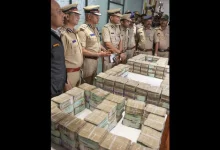Delhi : AQI Surges Past 400, Strangling Key Neighborhoods in Polluted Grip

As winter’s chill tightens its hold, Delhi’s skies have thickened into a suffocating shroud of smog, pushing the city’s air quality into the dreaded “severe” zone. At 7 a.m. on Sunday, the capital’s overall Air Quality Index (AQI) clocked in at approximately 430, a level that signals immediate health threats to residents breathing the contaminated air.
This alarming escalation caps weeks of deteriorating conditions, with the urban haze now classified as hazardous across much of the metropolis.
Isolated hotspots within the city have plunged even deeper into peril. Real-time data from monitoring stations revealed Wazirpur grappling with an AQI exceeding 450 and Bawana logging 435 early Sunday, marking them as epicenters of toxic buildup.
By 7:15 a.m., Jahangirpuri’s readings spiked to 438, embedding it squarely in severe territory. Nearby, Anand Vihar reported 427 and Ashok Vihar 421, illustrating the uneven but relentless spread of pollution that has left multiple districts gasping under invisible fumes.
The distress extends beyond Delhi’s borders into the National Capital Region (NCR). Noida’s AQI teetered at 390, brushing the severe line, while Greater Noida’s 380 confined it to “very poor” status. Ghaziabad fared worst among neighbors, with a severe 426 that amplified the regional smog crisis.
These figures stem from dangerously high concentrations of fine particulate matter (PM2.5 and PM10), slashing visibility and amplifying risks for respiratory issues, cardiovascular strain, and other ailments, especially for vulnerable groups exposed outdoors.
ALSO READ : Delhi-NCR Air Pollution: CAQM Strengthens GRAP Framework, Rnforces Stricter Curbs At Earlier AQI Stages
To counter the crisis, authorities have locked in Stage 3 protocols under the Graded Response Action Plan (GRAP). The Commission for Air Quality Management (CAQM) has mandated hybrid work arrangements in the area, capping on-site presence at 50% for private offices while urging full remote operations elsewhere.
Delhi Environment Minister Manjinder Singh Sirsa emphasized vigilant oversight, noting round-the-clock surveillance and the rollout of staggered office hours for Municipal Corporation of Delhi (MCD) and Government of National Capital Territory of Delhi (GNCTD) facilities to curb rush-hour vehicle emissions.
Compounding these efforts, the Delhi administration directed schools and educational bodies on Friday to suspend all sports and outdoor exercises, shielding students from the airborne menace.




